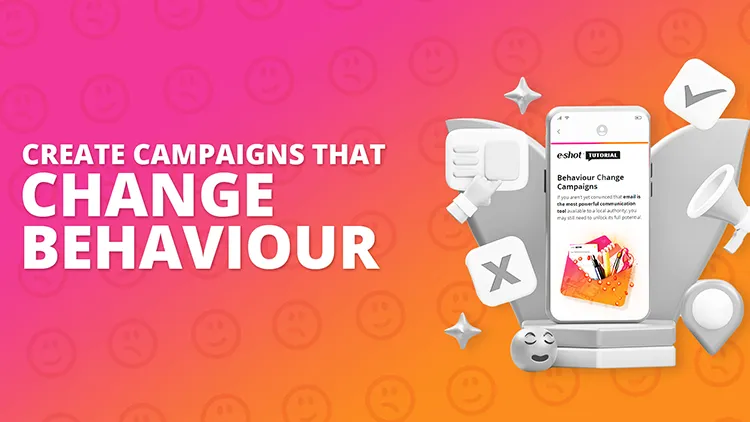Blog
CATEGORY: Public Sectoremail-marketing
Building successful behavioural change campaigns

Many government communications seek to change behaviours in order to implement government policy or improve society.
The objective of most behaviour change campaigns is to inspire a specific action or change in behaviour from your target audience. In essence, we are asking them to change negative behaviour for a positive one. Having a clear and measurable objective will help to ensure every piece of your overall campaign is working toward this goal.
People cannot be convinced to change their behaviour, but instead need to be motivated to change it on their own.
COM-B Model of Behaviour Change
The COM-B Model was developed by Susan Michie, Maartje van Stralen, and Robert West in 2011. At the time, many frameworks of behavior change interventions existed, and although many were successful, an overwhelming amount were ineffective. According to the COM-B model, in order to exhibit a behaviour an individual must have the Capability to do it, the Motivation to do it, and external factors must provide the individual with an Opportunity to do it.
Enabling Capability
A “capability barrier” occurs when a person cannot enact a behaviour due to not possessing the necessary awareness, knowledge, or skills. Campaigns that intend to encourage behaviour change by promoting awareness or providing educational information will typically be aiming to address capability barriers.
Motivating change
It is helpful to think of motivation as the beliefs and attitudes that drive enthusiasm, or lack of it, to enact a behaviour. Communications that intend to encourage behaviour change by evoking emotion, highlighting risks of inaction, or changing opinion about the importance of a behaviour will typically be aiming to address motivation barriers.
Understanding Opportunity
As all communicators know, clear instructions are not always enough to drive behaviour change. Audiences may face considerable other barriers to enacting the desired behaviour. An “opportunity barrier” occurs when a person does not enact a behaviour due to something outside their control - for example, lacking the money to pay a fee for a service, or lacking access to a computer to use an online tool.
Typically, communications alone cannot easily address opportunity barriers, as these sit outside the control of the audience. This is why it is particularly important to explore opportunity barriers at the outset, before devising your campaign/communications, as a campaign alone will not be sufficient to remove these barriers and drive behaviour change.
Understanding opportunity and tailoring your communications in light of this is something that should be investigated at the very start of your campaign planning. GCS gives two brilliant examples of how a campaign can be adapted to mitigate opportunity barriers:
“1. Shifting the target behaviour
It may be possible to remove opportunity barriers by changing the target behaviour of the campaign. For example, if a campaign aims to encourage park users to throw their litter away correctly, the audience may face the opportunity barrier that there is no nearby bin. A campaign could instead aim to encourage park users to take their litter home with them, removing this opportunity barrier.
2. Shifting the target audience
Some opportunity barriers may be caused to capability or motivation barriers faced by people outside the target audience, which communications could then target. For example, if a campaign intended to encourage children to eat more fruit at school, the children may face an opportunity barrier of there being no fruit available - which cannot be addressed by a campaign. However, this opportunity barrier (lack of fruit) may be caused by lack of motivation from a headteacher to provide fruit. Motivation barriers can be addressed by communications, therefore the campaign could instead aim to motivate headteachers to provide fruit at school.”
As a general rule, communications can typically only influence capability and motivation barriers. Opportunity barriers (resources and processes) are unlikely to be influenced by a communications campaign. In other words, a campaign can address knowledge and understanding (capability) and beliefs and attitudes (motivation) but cannot typically address a lack of resources, tools, or money, or access.
As part of the due diligence of developing the campaign strategy consideration should also be paid to “unintended consequences” to ensure that the campaign also takes into account these possibilities as although there may be additional unexpected positive results any potential negative repercussions should also be duly considered. Take a look at our article “Complimentary campaigns: Mitigating unintended consequences “ (https://gcs.civilservice.gov.uk/wp-content/uploads/2021/07/GCS_IN_CASE_A_behavioural_approach_to_anticipating_unintended_consequences.pdf)
Building your campaign
With the objective defined, the next step is breaking it out into key phases or milestones. Behaviour change is long-term – it doesn’t happen overnight, and each phase of decision-making could be a lengthy period.
It is important to focus the phases of your email campaign on motivating the individual to move along the journey from precontemplation to action, with each email serving as a building block to drive that motivation. If you need help defining the phases of your automation, try grouping it into the Stages of Change by Prochaska/DiClemente:
Precontemplation, Contemplation, Preparation, Action, & Maintenance.
This model has similarities with the more commonly known AIDA ‘customer journey’ model which sales and marketing professionals are more likely to come into contact with – Awareness, interest, desire, action. To be fair, either approach gives you a structure within which to build your communications, it is down to your messages to provide the right level of information and persuasion for the stage of the journey. Indeed, the steps loosely correlate precontemplation = awareness, contemplation = interest, preparation = desire and then finally action.
Effective automation
Behaviour change marketing is all about identifying barriers to change and increasing motivations to encourage positive steps, which makes it a good fit for long-term email automation campaigns. Email automation campaigns give you the ability to communicate with an audience on an individualised level over a short or long term. With email automation campaigns, you can also choose the cadence (frequency of contact) and length of your campaign.
A long-term automation campaign deployed to your audience allows you to keep your programme front of mind, while incrementally feeding messages that lower the barrier, increase intent to change, and motivate the individual towards your desired outcome. Even better, automation campaigns can be built to easily (and automatically) tailor or pivot the message the person receives based on their engagement (or lack thereof!) with your initiative.
Manage your measures
Before you go off and write your emails, you will want to map out how you will measure each phase and the overall effectiveness of the automation campaign.
For each phase of your long-term automation, choose an appropriate key performance indicator (KPI) that demonstrates an individual’s completion of one phase and progression onto the next.
N.B. When building your automation the first two stages need to be substantial – general rule of thumb is 40% precontemplation/awareness, 40% contemplation/interest, 20% preparation/desire.
Map out your key messages within each phase & develop your content
Now that you have defined who you are targeting and desired outcomes, knowing where they are on the hierarchy of change, it’s time to map out the messages for each email and the order in which they will be deployed.
As you define the key messages, think about them building upon each other, and keep the messaging motivated to where that person is in the hierarchy. Think back to COM-B focus on capability where you will likely focus on education, and motivation where the focus will likely be more emotive and social proof based messaging – but make sure with every touch-point you clearly answer your readers primary question “what’s in it for me?”.
Solutions
Email marketing healthcheck
We are confident that we can help you, which is why we offer a free healthcheck to identify potential issues with your current programme and free advice on things that could be done to improve it.
)-(Presentation)-(1000-x-563-px).jpg)

.jpg)